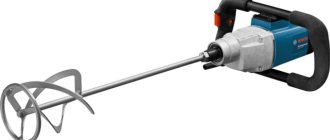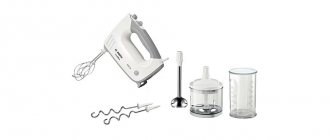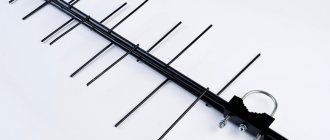The mixer is known to almost every housewife, since the first simple models of this device were distributed back in Soviet times. A blender is an improved version of a mixer, and it appeared on the market relatively recently.
The names of these devices are taken from English words whose meanings are almost identical: “mix” and “make a mixture.”
In fact, a mixer and a blender are completely different devices that have different functionality and are used in different situations.
What is a blender for?
The working element of the blender is rotating sharp steel blades . Thanks to this design, the blender easily chops fruits and vegetables; it can be used to crush ice, nuts or crackers.
The chopping ability depends on the power of the device; in addition, blenders are of manual and stationary types.
A hand blender is similar to a mixer, as it consists of a handle with control buttons and an attachment with steel blades, which is immersed in a container. Some models include a special bowl for chopping food, or an additional attachment - a whisk for whipping liquids.
A stationary blender is a body with a container inside which there are rotating steel knives. To use such a device, you should place the necessary products in a glass, close it with a lid, turn on the blender at a given power, after which the ingredients will be crushed in a few seconds.
Like any device, a blender has some advantages and disadvantages.
Its advantages:
- grinds raw, cooked fruits and vegetables, as well as solid foods;
- has high speed;
- is able to grind products to a homogeneous consistency;
- With additional attachments, it can perform many actions.
Flaws:
- mixed products lack airiness;
- due to high speeds, the blender quickly heats up and often requires a break in operation;
- makes a loud noise;
- The immersion type can only chop a certain portion of the food, so it needs to be constantly guided.
The versatility of a blender can also be a disadvantage, since some functions (for example, whipping or chopping) are not performed as well as when using separate devices designed for this purpose.
About
What is a mixer for?
The difference between a mixer and a blender is that the first ensures mixing of products thanks to rotating whisks made of durable metal.
This device allows you to mix and beat liquid products, so it is used for whipping eggs, cream, creams, dough and making cocktails.
Mixers vary in degree of productivity, and are also divided into manual and stationary devices.
A hand mixer is a device with a handle and a whisk-shaped attachment. When working, it is immersed in a container with products. It's great for whipping and mixing liquid ingredients, but it won't cope well with harder ingredients.
A stationary mixer, just like a blender, consists of a container placed on a body with control buttons. It is used in the same cases as a hand mixer, the only difference is convenience, since such a device frees your hands.
Typically, a stand mixer is equipped with a special bowl, the volume of which is up to 2 liters, a whisk attachment and a special attachment for kneading thick dough.
It may be noted that the power of a hand mixer is usually 400 W, while that of a stationary mixer can reach up to 700 W. Accordingly, the operating speed of a hand-held device is almost 2 times lower. This can be both a disadvantage and an advantage, since at low speeds the mixture of products is better saturated with air.
A mixer is a fairly simple technical device; its first models were based on physical strength and were not connected to electricity, which led to its long-standing prevalence. It is most often used for making baked goods.
The popularity of the mixer is explained by the following advantages:
- allows you to obtain an airy and fluffy mixture;
- suitable not only for whipping liquid ingredients, but also for kneading dough of different consistencies;
- does not overheat during operation, so can be used for a long time;
- Provides fast and convenient whipping.
Of course, the device has its drawbacks:
- not suitable for grinding ingredients;
- will not cope with excessively thick or hard products;
- the scope of application is limited to liquid and semi-liquid components;
- makes noise when working.
The disadvantages also include the fact that a stand mixer takes up a lot of space (which is not always convenient in limited kitchen space), but the same applies to a stand mixer.
About
Main features of the difference between a mixer and a blender
Housewives often wonder how a mixer differs from a blender. One is intended for mixing, mainly used for confectionery purposes, and the second is for grinding hard products. The second device has wider functionality. The rotation speed of the blender is up to 20 thousand revolutions per minute, and the mixer has a maximum of 15 thousand.
The mixer is used for mixing confectionery compositions.
See alsoTile kitchen apron: design and new ideas in 2021
What is the difference?
In the process of cooking, there is often a need to beat, stir or chop various products, and it is worth noting that for many operations both a mixer and a blender can be used.
To figure out which device should be used in each specific case, you can use a special table of the most common operations with products.
| Type of transaction | Blender | Mixer | |
| Stationary | Manual | ||
| Shredding vegetables/fruits | Yes | average | No |
| Making puree | Yes | average | No |
| Grinding nuts/breadcrumbs | average | Yes | No |
| Ice crushing | Yes | average | No |
| Making cocktails | Yes | average | average |
| Beating whites/yolks/eggs | No | average | Yes |
| Making homemade mayonnaise | No | No | Yes |
| Batter for pancakes | average | average | Yes |
| Dough with the consistency of thick sour cream | No | average | Yes |
| Pie dough | No | No | Yes |
About
conclusions
When choosing between a mixer and a blender, it is important to remember the following nuances:
- a hand mixer is suitable for simple tasks , but a stationary one will help you prepare a large number of different dishes;
- for cooking solid foods, it is better to choose a blender - it is much more functional, but its cost is slightly higher;
- the main technical parameters of the devices are power consumption and the number of operating speeds ;
- special attention must be paid to the safety system, quality of materials and workmanship, as well as the number of replaceable nozzles;
- For convenient use, you should give preference to a model with a long power cord.
Which is better to choose?
It is best to have two appliances in the kitchen, designed for different operations. If circumstances are such that you need to choose one thing for your home, then you should first evaluate the advantages and disadvantages of each device.
First of all, you must decide which dishes are most in demand in your family. For example, if you like to make baked goods or a variety of desserts, then you will definitely need a mixer. If you have a small child, or you often prepare pureed dishes, then a blender is perfect.
You need to understand that a mixer is used for mixing and beating liquid ingredients, but it is not intended for grinding. The blender, in turn, is capable of grinding not only fruits and vegetables, but even nuts or ice.
A mixer cannot perform the functions of a blender, while a blender in some cases successfully replaces a mixer; it can be used to beat cream, eggs or sauce, and prepare homogeneous cocktails or smoothies.
The functions of these two devices often overlap, but when choosing, you should still focus on the main purpose of the device, since additional tasks are not always performed efficiently.
Mixers tend to have less power, so even with a blade attachment, they won't produce as good a mixture as higher-powered blenders.
About
Tips for choosing
When choosing a device, pay attention to several characteristics:
- Power. It determines how efficiently the unit will operate. Unlike devices with high power, with low power they deteriorate faster and overheat.
- Material of the body and nozzles. Everything should be as strong and dense as possible. This is a kitchen job, which means food particles should not get stuck in small holes and crevices.
- Availability of various modes. This is important if you are making different dishes.
- Easy to use and clean. If the equipment is difficult to assemble, it will not be convenient and comfortable for the housewife.
When purchasing kitchen appliances, special attention should be paid to the power of the device.
Important! When choosing a device, it is better to give preference to proven popular brands, regardless of what exactly you choose. Their prices may be higher than other brands. But the price most often corresponds to the quality. Don't skimp on yourself.
Mixer and blender - 2 in 1
The fundamental difference in the main purposes of a mixer and a blender has led to the appearance on the market of combined devices, for example, blenders with a mixer function.
In addition, you can find sophisticated food processors that not only chop and beat food, but are also capable of squeezing juice, chopping meat, grinding coffee and cereals, etc.
The most common devices are 2-in-1 mixer-blenders, but sometimes there are even 3-in-1 models. As a rule, they are compact in size, do their job well, and their cost is quite reasonable and will not put a hole in the family budget.
Two-in-one devices perform the same functions as both a mixer and a blender. This is very convenient, since you can immediately chop vegetables, mix them to the required consistency, make purees, add beaten egg whites - the variety of operations is limited only by the availability of products in the house.
It is worth noting that such hybrids can be quite simple and have low power. There are also universal devices with increased productivity that allow you to carry out the necessary operation by pressing the desired button.
The simplest hand mixer blenders consist of the following parts:
- housing with control unit;
- a chopping attachment with steel blades, which is used as a blender;
- a whisk attachment necessary for whipping liquids.
At the other end of the model range there are serious devices with high power, significant productivity and increased bowl volume (up to 6-7 liters). As a rule, such devices are used in large families, where they often like to cook a wide variety of dishes.
Their disadvantages include the following:
- high cost (up to 10 thousand rubles);
- loud noise during operation;
- significant energy consumption;
- difficulty of operation.
In some devices, power is distributed unevenly depending on the functions performed. In addition, a large appliance can weigh up to 10 kg and requires a permanent place in the kitchen, which is not always convenient in limited space.
Most often, budget small models are used, which quickly gained popularity in the kitchen goods market. They are easy to use, have sufficient power, are of high quality and inexpensive.
The capabilities of such a two-in-one device are quite enough to satisfy the needs of the average family, if from time to time you need to beat eggs or prepare vegetable puree.
About











